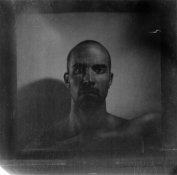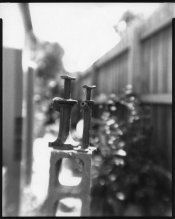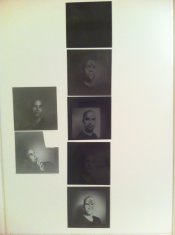here're some scans of the photographs I made yesterday, all calibrated to maximize the scanner's range and replicate the relative tonal characteristics of each image. i scanned in color because there are slight hue differences with different exposure levels. i have not manipulated these images at all to make them comparable, but the actual photos have a characteristic gray-brown hue to them, rather than the blue or green color these scans show.
first, a little more technical information about the procedure. i placed myself in the focal plane, which i established with a no. 2 diopter and racking the bellows in all the way at wide open (Sekor 80mm f 2.8 blue dot). camera is loaded with lightly flashed paper, lights on, expose, lights off, develop to completion (1 min), flash for reversal, develop to completion (+water bath soak to a stop), fix, lights on and figure out what to do for the next one. as above, i metered the bathroom light at EV 3.5 for EI 12 and eye-balled exposure from there.
the first image was an overall failure. the following (second) plate was made with a 5s exposure with the flash. reversal exposure was roughly 0.2s. obviously blown highlights on my nose and forehead retained their density in the reversal process, and average density was high with a low contrast.
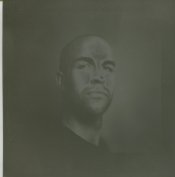
this next plate was exposed for about 3.5s with the flash and the door open (with light from my room lights and outside through the window). the reversing flash was a touch longer, about 0.25s. nice high density on the frame edge, and shadows, less held-over black blown out highlights, although the overall contrast is ridiculous and detail is only on my ear and neck where the exposure was lower.

this plate had an exposure of 3s with the door closed, and the flash. the reversing exposure was about 0.25s. better detail, no blown highlights, but again low contrast and higher average density.
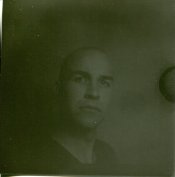
this plate had an exposure of 6s, without the flash (didn't fire the first time so did a double exposure). reversing exposure was much shorter, about 0.1s. terrible blowing of highlights again. however, i was encouraged by the very high overall contrast generated by the short reversing exposure.
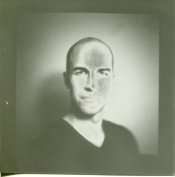
this plate was essentially all bulb, ~1.5s exposure. reversing exposure was at first 0.1s, but i saw the negative showed no perceptible density after a full minute of development. after a few seconds of development in the dark and not seeing any color change i flashed again for 0.1s, and developed for a full minute and let it rest in the water bath hoping something would come out. great tonal range, detail, lower average density, better overall contrast. this is my favourite photo, basically an accident (but a happy one).
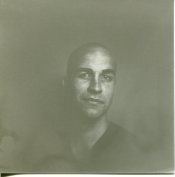
this plate was ~2s exposure with flash, and a 0.1s reversing exposure (maybe shorter). i trusted that the nearly-zero observed negative density would produce a positive image, and produced a high contrast, low maximum density image. there is a black mark in my left eye (remember, rotated inverse images) from a blown unreversed highlight. as a side note, i'd ripped the corner off to test my developer that had been sitting in the tray at the start of the day to see if it was good having been mixed a couple days before (it wasn't, so i started this series of photos with fresh).
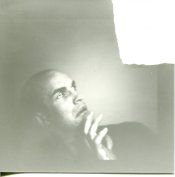
this was my most successful image from my first experiements with this approach, and was produced essentially by accident. scanned with the same scanner, same settings, for comparison. exposure for this image was with my flash (bare) held at arm's length, shot twice, ~20s exposure in lower incident light only through my bedroom window. reversing exposure roughly 0.2 seconds (i'm guessing, this was a month ago).
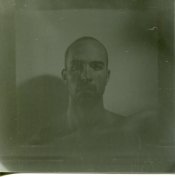
so it seems to me that there is a LOT of leeway for producing a recognizable photograph, but definitely needs dialing in to get good repeatable results. flatter, even lighting seems to have the ability to produce good detail and appealing contrast. from my experiments it seems that the strength of the latent image is less important than the duration of the reversing exposure--longer secondary exposure can compound with long initial exposures and solarize the crap out of your image. good, healthy developer seems to help the process along to generate good positive density, but definitely hurts tonality with fogged highlights and lower contrast.
this information is all but useless, and is really just a place to start for anyone else interested in experimenting. i'm sure you'll all pay closer attention to what you're doing than i have.






 Either that or buy some direct positive paper or a reversal kit.
Either that or buy some direct positive paper or a reversal kit.